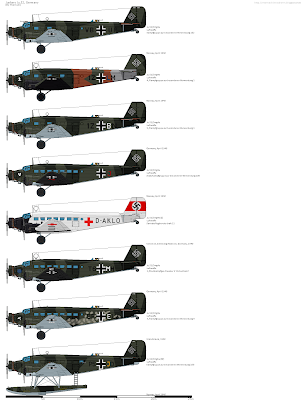As the Ju.52 was originally conceived, the Ju.52/1m, it was powered by a single engine, either a BMW IV or a liquid-cooled Junkers V-12. This model, however, was deemed as seriously underpowered and, after seven prototypes having been built, every subsequent Ju.52 was built in the three engine configuration, being denominated as Ju.52/3m (drei motoren - three engines). Those engines were ,at first, three Pratt & Whitney R-1690 Hornet, but later production models were powered by three BMW 132 which delivered up to 770 hp each and were themselves, a licensed copy and refinement, of Pratt & Whitney's design. Some export models were built with Pratt & Whitney R-1340 Wasp engine (delivering up to 600 hp) and Bristol Pegasus VI (delivering up to 775 hp).
Thanks to its excellent reputation as an airlines with Lufthansa, the Luftwaffe adopted the type as its standard transport airplane. In 1938, the 7. Flieger-Division alone had five transport groups with a total of 250 Ju.52. At the outbreak of World War 2, the whole Luftwaffe had a total of 552 Ju.52, although the aircraft was already considered being obsolete. Between 1939 and 1944, when German production ceased, a total of 2.804 machines were delivered to the Luftwaffe, 145 in 1939, 388 in 1940, 502 in 1941, 503 in 1942, 887 in 1943 and 379 in 1944, however, by the end of the War, there were only 100 to 200 serviceable.
The first major operation the type was involved in, after the bombing of Warsaw, was in Operation Wesserübung, the German invasion on Denmark and Norway, on 9th April 1940. Fifty-two Ju.52 belonging to 1. and 8. Staffels of Kampfgeschwader 1 transported a company of Fallschirmjäger (paratroopers), plus an infantry battalion to the northern part of Jutland peninsula to capture the airfield in Aalborg, a key objective tu support operations in southern Norway. Many hundreds Ju.52 were also used to transport troops to Norway during the first days of the invasion, including the difficult, yet successful airborne assault on the Norwegian airports of Oslo-Fornebu, Stavanger-Sola and the bridge at Vordingborg. In the late stages some Ju.52/3m of the KGzbV 102 flew artillery to the German forces at Narvik, having to land on the frozen ice of Hartvigann lake. As those lacked the fuel to make the return trip, they were abandoned by their crews and the machines sank to the lake's bottom when the ice melted next spring.
During this operation, the Ju.52 of the Luftwaffe, performed a total of 3.018 sorties, 1.830 of which were to carry troops and remainder to carry cargo and supplies. By the end of the operation, a total of 150 Ju.52 were recorded as lost with a total of 29.280 personnel, 2.376 tons of supplies and 259.300 imp. gallons (1.179L) of fuel transported.
Many Ju.52/3mg4e (see), the floatplane variant, were assigned to KGzbV 108 See in early 1940 to be employed in the invasion of Scandinavia. These were used mainly to deliver troops and supplies to various islands and fjords which were, otherwise, inaccesible for German forces.
Sources:
1. https://en.wikipedia.org/wiki/Junkers_Ju_52#Military_use_1932–1945
2. https://www.axishistory.com/books/151-germany-luftwaffe/luftwaffe-ground-units/5604-7-flieger-division
3. https://www.valka.cz/Junkers-Ju-52-t16146 (translated)
4. Signal Squadron - Aircraft In action 186 - Junkers Ju-52 in Action
5. Osprey - Combat Aircraft 120 - Ju 52/3m Bomber and Transport units 1936-1941


No comments:
Post a Comment